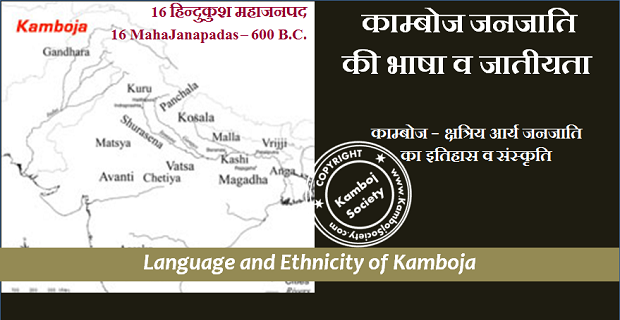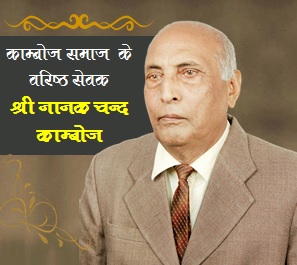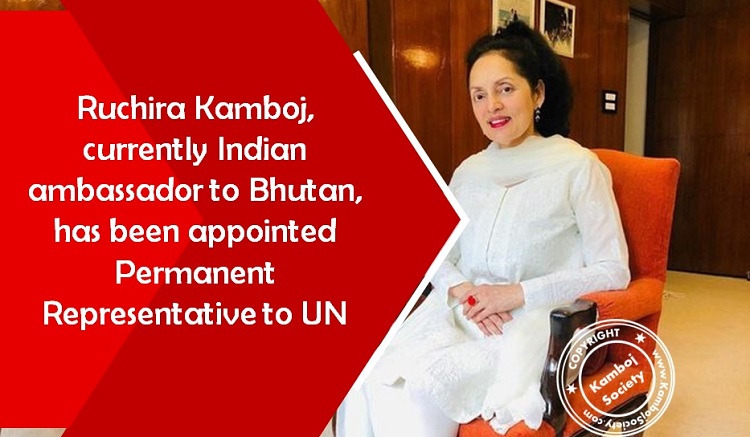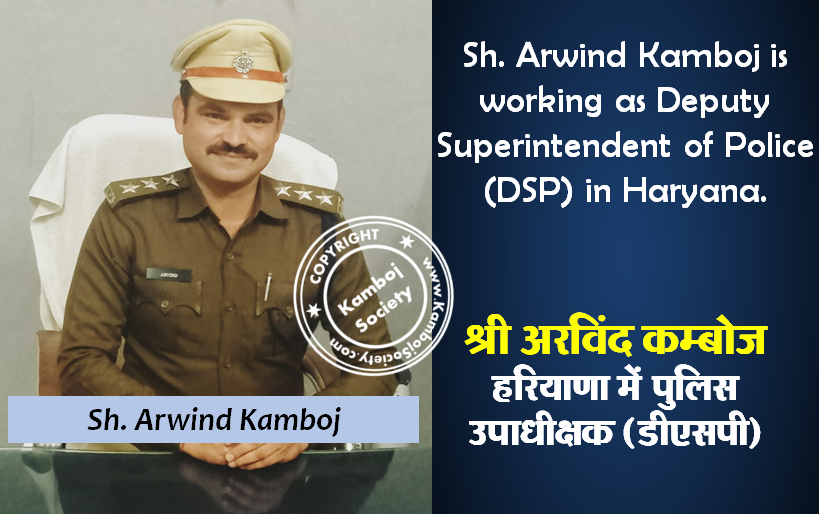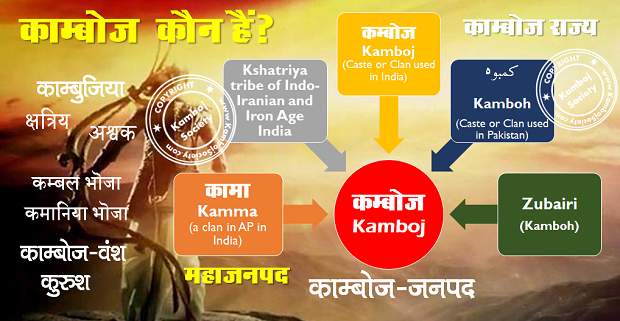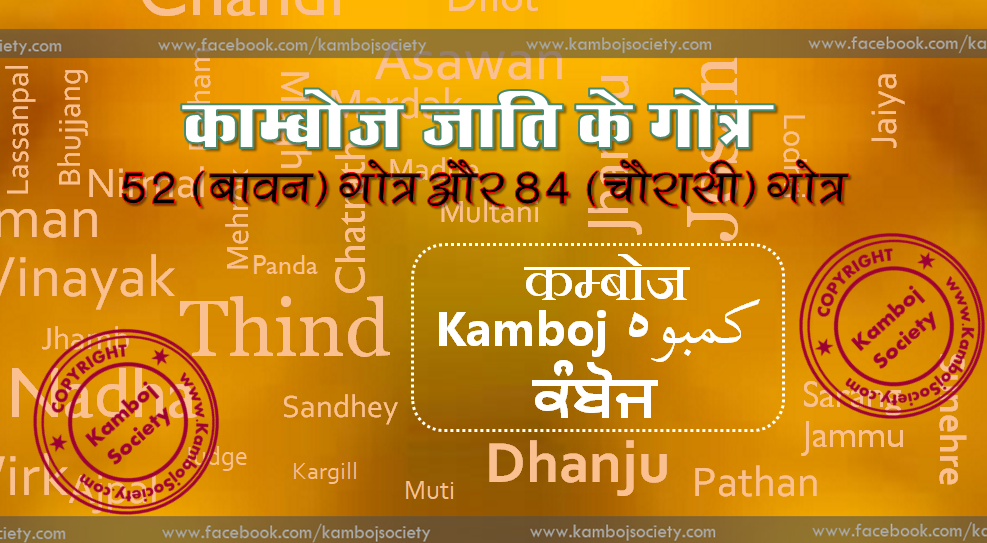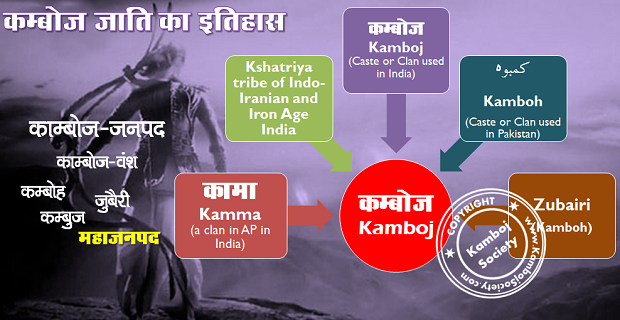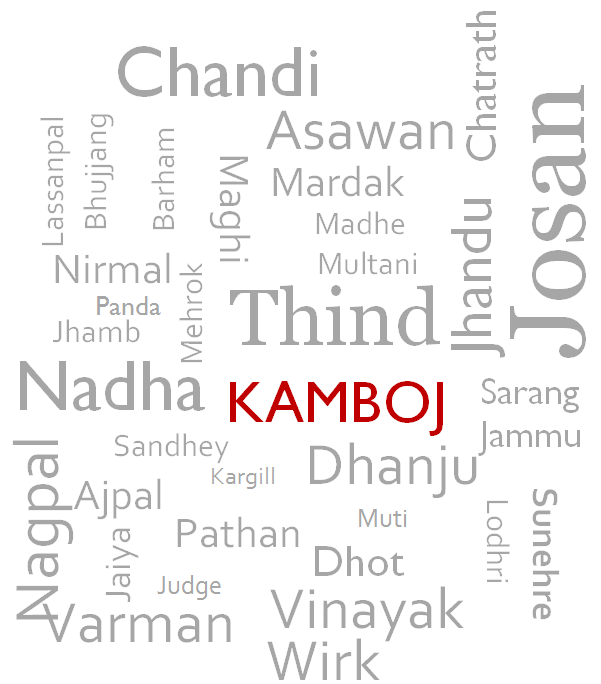Kamboja was the ancient name of a country and the tribe settled therein. Buddhist Jatakas, Yaska's Nirukata, Herodotus (Book I.140), Avestan|Avestic texts and numerous Brahmanical literature indicate that Kamboja was the center of Iranian peoples|Iranian civilization. This is evident from the Zoroastrian|Mazdean religious customs of ancient Kambojas as well as from the Avestic dialect they spoke. It is also widely accepted among the scholars that the Kambojas formed Avestan speaking group of the East Iranian peoples|Iranians and were located mainly in north-eastern parts of Afghanistan and parts of Tajikstan. It is also stated that that the Zoroastrian religion had originated in East Iran in the land of the Kambojas.
Yaska's Nirukata on Kambojas
Seventh century BCE Nirukata of Yaska contrasts the speech of the Kambojas with that of the Aryans i.e Indo-Aryan languages|Indo-Aryans:
Patanjali's Mahabhasaaya on Kambojas
Almost similar information on the Kambojas is also provided by Patanjali's Mahaabhaasya (2nd c BC).
The foregoing ancient evidence by Yaska and Patanjali conveys the following saliant information:
- The Kambojas were not the same as the Indo-Aryans, since the Nirukata contrasts the Kambojas with the Indo-Aryans,
- The language of the Kambojas was different from that of the Indo-Aryans since the Indo-Aryan spoke Sanskrit, while the language of the Kambojas was not.
Sir G. A. Grierson notes that the Kamboja verb shavati is not found in ancient Sanskrit literature but it is a well known Iranian peoples|Iranian word (The Language of the Kambojas, Journal of Royal Asiatic Society, 1911, p 802).
Dr Michael Witzel notes that the Kamboja verb shavati represents, sound by sound, the Young Avestan sauuaiti in the sense 'to go' (Persica, 9, 1980, p 92).
Dr Ernst Kuhn's views
Based on Yaska's Nirukata and a Jataka gatha (from Bhuridatta Jataka), one noted German people|German scholar, Dr Ernst Kuhn had opined in 1904 that the Kambojas spoke a language embodying specialities of both the Sanskrit as well as Iranian peoples|Iranian language, and further as a part of their religious practice, the Kambojas considered it a religious duty to kill snakes and other poisonous insects (Das Volk Der Kamboja bei Yaska, First Series of Avesta, Pahlavi and Ancient Persian empire|Persian Studies in honour of the late Shams-ul-ulama Dastur Peshotanji Behramji Sanjana, Strassberg & Leipzig, 1904, pp 213 ff, Dr Ernst Kuhn).
Dr Grierson's earlier views
Based on Nirukata, Dr G. A. Grierson wrote in 1911: 'The Kambojas, a barbarous tribe of north-western India, either spoke Sanskrit with an infusion of Iranian words to which they gave Indian inflexions or else they spoke a language partly Indo-Aryan and partly Iranian' (The Language of the Kambojas, Journal of Royal Asiatic Society 1911, pp 801-02).
Bhuridatta Jataka on Kambojas
Following Dr Grierson's investigations on Kambojas which appeared in 1911, Dr Kuhn published a summary of his own article (Das Volk Der Kamboja bei Yaska) in English, in Dr Grierson's support in the 1912 issue of Journal of Royal Asiatic Society which included comments from Dr Grierson as well.
Dr Kuhn had specifically drawn Dr Grierson's attention to the following verses on Buddhist Jataka on the Kambojas (Fausboll, Jataka, Vol VI, pp 208, 210)
Dr Grierson's changed views
That the killing of lower animals is a Zoroastrian religious practice is amply attested from the passages in Mazdean books like the Videvati (XIV.5-6) as well as from the remarks of Herodotus (I.140) about the Persian empire|Persian religion.
The above disclosures from Bhuridatta Jataka completely changed Dr Grierson's views on the Kambojas. Thence-afterwards, he started considering the Kambojas an undoubted tribe of the Iranian peoples|Iranians.
Dr Grierson re-wrote: "This gatha, by itself, establishes a close connections between the ancient Kambojas and the ancient Iranians with whom the destruction of noxious or ahramanic creatures was a duty...............Beyond any reasonable doubt that the Kambojas were a tribe of the Iranians " (Journal of Royal Asiatic Society, 1912, p 256)
Further evidence on Kambojas being non-Indo Aryans
Mahabharata on Kamboja culture
Mahabharata speaks of the Yavanas, Kambojas, Darunas etc as the fierce barbarians from Uttarapatha,
and further reckons them among the sinful people, characterised by practices similar to those of chandalas and vultures i.e avaricious and greedy. e.g:
Furthermore, along with numerous other non-Vedic civilization|Vedic tribes of north-west, the Kambojas are branded as fallen rogues, leading sinful lives like those of the Dasyus (MBH 12.65.13-15).
The above Mahabharata evidence reinforces Jataka's views that the Kambojas, in culture and customs, were different from the Indo-Aryans.
Majjhima Nikaya on Kamboja social customs
Assalayanasutta (II.149) of Majjhima Nikaya attests that in the lands of Yavanas, Kambojas and some other frontier nations, there were only two classes of people...Aryas and Dasas...the masters and slaves. The Arya could become Dasa and vice versa:
The Vishnu Purana also affirms the absence of chatur-varna system among the Kiratas in the east and the Yavanas, Kambojas etc in the pashchima or west (Vishnu Purana, 2.37).
Apparently, this two-class social practice of the Kambojas and Yonas differentiated them from the Indo-Aryans who believed in Brahmanical varnasharma.dharama and had practiced chatur-varna or four-clas s social system.
Panini's Ganapatha on Kamboja/Yavana culture
Ganapatha 178 on Panini's rule II.1.72 - Mayuravyamsakadi : differentiates the Kambojas from Indo-Aryans saying that Kambojas practiced wearing short head-hair (Kamboja-mundah Yavana-mundah) where as the Indo-Aryans usually wore long hair or else supported only a top knot. This fact is also attested from Mahabharata (7.119.23) as well as from numerous Puranas.
Kamboja: a non-Brahmanical society
The Commentary [Majjhima Commentary, II, p.784] says that if a Brahmin goes to Kamboja or Yavana with his wife for purpose of trade and dies there, his wife would be compelled to work for her living and her children would become slaves. This shows that, in contrast to Indo-Aryans, there was no place for Brahminas in the land of Kambojas and Yavanas.
Ashoka's R. E. XIII also alludes that in the lands of Yonas and Kambojas, the Brahmanas and Shramanas were not entertained.
Manusmriti (X.43-44) and Mahabharata (12.65.13-15) etc also affirm that the Kambojas, Yavanas, Sakas etc had ignored the Brahminas and the Brahmanical rituals, which had formed the very basis of the Indo-Aryan society.
Kamboja.sutta of Anguttara Nikaya as well as the ( Manorathapurani Commentary (II, p 523) forewarns the women from other countries not to visit Kamboja, even in spite of their desire. This implies that the Kamboja society was incompatible with that of the Indo-Aryans.
The foregoing numerous evidence amply attests that the language, culture, social customs and manners of the Kambojas were different from those of the Indo-Aryans.
Devi Bhagawatam & Markandeya Purana evidence
The Kambojas have also been referred to as Asura demonic warriors in Markandeya Purana (8.1-6) as well as in Srimad Devi Bhagawatam (5/28/1-12) etc.
These ancient texts refer to a Mythology|mythological war of goddess Durga/Ambika with some Asura/Demon clans of north-west like Udayudh, Kambu, Kotiveerya, Kalaka, Daurhrita, Kalkeya, Maurya etc (obviously, all Iranians).
There is reference to eighty-four select warriors from the Kamboja|Kambu (Kamboja) clan accompanied by numerous Kambu fighters set on a ferocious war with the deva forces of goddess Durga (Glory of the Divine Mother (Devi Mahatmyam), p 211, Sri Sankaranarayanan).
Dr Raychaudhury identifies the Maurya Asura clan of the above texts with the Maurya clan of Chandragupta Maurya (Poitical History of Ancient India, 1996, p 4-5).
And scholars like Swami Vijnanannanda correctly identify the Asura Kambu clan with the Kambojas of Hindukush and their allies Kalkeyas with the Afridis etc (See: The Shrimad-Devi-Bhagawatam, trans: Swami Vijnanananda (1921-22), p 451).
It is notable that the great Asura warrior king Shumbha, the hero of the Asura/Danava forces, has been referred to as danuja-lord the son of Diti (i.e ditija-danuja-adayah) in Shri Devi Bhagawatam as well as Markandeya Puraana traditions etc (Devi-Mahatam verse 9.30).
It is also notable that great epic Mahabharata also mentions one king Chandravarman of the Kambojas, who has been referred to as an incarnation of the great Asura/Daitya Chandra and addressed as ditija.shreshtho i.e. foremost among the Asuras, the son of Diti
Diti was perhaps a local cult deity affected in Hindukush.
This reference also alludes to Iranian peoples|Iranian affinities of the Kambojas. The mythical Asura king Shumbha of Puranic Hindu texts appears to refer to some derring-do warrior from the Iranian Kambojas of north-west. And the Durga/Shumbha legend probably refers to some dimly remembered remote tradition on border clashes between the ancient Iranian peoples|Iranian Aryans and the Vedic civilization|Vedic Aryans, after the great divide had occurred.
Probably, the Ditija Chandravarman (a Kamboj) of Mahabharata and Ditija Shumbha of Merkendeya Purana/Srimad-Devi-Bhagawatam texts refer to same personage.
Asura was the name by which the ancient Indo-Aryans addressed their ancient Iranian neighbors. The same word is found as Ahura in ancient Persian traditions. The Asuras or Ahuras were Iranians followers of Ahuramazada (Zoroastrian religion) which the Kambojas indeed were. Initially, the word Asura did not have the negative (demonic) connotations which it got only in later times. The Iranians, on the other hand, called the Indo-Aryans as Daivas on account of their being Deva worshippers which term also carried similar demonic connotations.
Some scholarly opinions on Kambojas' ethnicity
Dr V. S. Aggarwala: "As shown in the Jataka and Avestan|Avestic literature, the Kamboja was a center of ancient Iranian civilization as is evidenced by the peculiar customs of the country " (The Kamboja Janapada, Jan 1964, Purana, Vol VI, No 1, p 229; Jataka edited by Fausboll, Vol VI, p 210 ).
Dr J. C. Vidyalankar: "Zoroastrian religion had probably originated in Kamboja-land (Bacteria-Badakshan)....and the Kambojas spoke Avestan language..." (Bharatiya Itihaas Ki Rup Rekha, p 229-231, Dr Jaychandra Vidyalankar).
Dr Michael Witzel: " The Kambojas, located somewhere in east Afghanistan, spoke Iranian language and followed Zoroastrian habits of killing lower animals " (Early Eastern Iran and the Atharvaveda, Persica-9, 1980, fn 81, p 114; Electronic Journal of Vedic Studies, Vol. 7 (2001), issue 3 (May 25), Art. 9).
Dr D. C. Sircar: " The Kambojas were of Iranian extractions....they were settled in Afghanistan region in Uttarapatha. Their numbers were occasionally swelled by new migrants from Iran, especially during age of Achaemenians." (Purana, Vol V, No 2, July 1963, p 256, Dr D. C. Sircar).
W. J. Vogelsang and Willem Vogelsang: "The name Kamboja was commonly applied in Indian sources to the Iranian population of the borderlands i.e Afghanistan " (The Afghans (Peoples of Asia), 2001, p 127).
Dr R. Thapar: "The Kambojas were a tribe of the Iranians " (History of lndia, Vol. I, 1997, p 276).
E. Benveniste: "The Kambojas..... were known in Indian traditions as a foreign people, with peculiar customs, ... raised celebrated horses, spoke - as the Nirukata (II,2.8) tells us - a language with Iranian words in it..... and had, according to Buddhist Jataka (VI.206, 27-30), a certain religious practice - the killing of insects, moths, snakes and worms - which we may recognize as Zoroastrian|Mazdean from the passages in Mazdean books like the Videvati (XIV.5-6) as well as from the remark of Herodotus (I.140) about the Persian religion " (Journal Asiatique, CCXLVI 1958, I, pp 47-48, E. Benveniste).
The noted scholars like C. Lassen, S. Levi, M. Witzel, J. Charpentier, A. Hoffman, A. B. Keith, A. A. Macdonnel and others have traced the ethnic name Kamboja in the royal name Kambujiya/Cambujiya of the Old Persian Inscriptions (Cambyses/Kambuses of the Greeks). Kambujiya (also Kambaujiya) was the name of several great Persian empire|Persian kings of Achamenian dynasty. The same name appears as C-n-b-n-z-y in Aramaic, Kambuzia in Assyrian, Kambythet in Egyptian language|Egyptian, Kam-bu-zi-ia in Akkadian, Kan-bu-zi-ia in Elamite, and Kanpuziya in Susian language.
H. W. Bellow observes: "Darius III succeeded, about 521 B.C to the empire founded by Cyrus (Kurush), and enlarged and consolidated by his son and successor Cambyses (Kambojia, Kambohji). Cyrus-whose mother was called Mandane of Media|Mandane (Mandana, perhaps a princess of the Mandan tribe), and said to be a Mede, and whose father was called Cambyses (Kambohji, probably a chieftain of the Kamboh tribe) having reduced the Medes and conquered the kingdom of Croesus the Lydian (Ludi), thereby became master of all the territory extending from the Indus to the Hellespont".
Kambujiya|Kambujiya III (Cambyses|Cambyses III) is famous for his conquest of Egypt (525 B.C.) and the havoc he had wrought upon this country.
Iranian vs Indian affinities of the Kambojas
There are also references in Sanskrit literature which suggest that a section of the Kambojas was probably also under Vedic cultural influence.
There is reference to a sage from Kamboja clan mentioned in the Vamsa Brahmana (1/18-19) of Sama Veda. Sage Kamboja is referred to as the pupil of sage Shaungayani Madrakara. Sage Madrakara belonged to Uttara Madras|Uttara-Madra tribe (Vedic Index). These Uttra-Madras were an Iranian settlement of the Bahlika Uttara-Madras (Jean Przyluski).
An ancient Vedic civilization|Vedic Chudakarma Samskaara in Paraskara GrhyaSutram lists the Kambojas with the Vasishthas as a scholarly clan sharing common social and religious customs with them.
These and similar references from ancient Sanskrit literature prove that a section of Kambojas had indeed also come under Indo-Aryans|Indo-Aryan cultural influence at some point in history.
In the light of evidence presented above, several scholars opine that the Kambojas had both Iranian peoples|Iranian as well as Indian affinities (Macdonnel, Keith, Dr Donald N. Wilber, W. K. Fraser, M. C. Gillet etc).
Classical defintion of Scythia/Scythians
Strabo defines all Central Asia|Central Asian clans inhabiting east of Caspian Sea as Scythia|Scythic or Scythia|Scythian in culture (See: Lib.xi, p 254; See also: Annals and Antiquities, I, p 49, fn 6, James Tod).
Diodorus further improves upon this definition and makes Mt Hemodos as the dividing line between Scythia and India proper (See: Indika, Fragment 1, Diodorus II.35; See also: Annals and Antiquities, I, p 49, fn 6, James Tod).
Mt Hemodos of the Greeks is stated to be Himalaya (Qv: Nonnos Dionysiaca 40.260).
Mt Hemodos is also known as Himaos Imaos and Paropamisos but Greeks generally called it Kaukasos i.e Caucasus which was Greek language|Greek designation for Hindukush (Qv: Fragment IV, Strabo XV.i. II, p 689).
Himalaya of ancient Sanskrit/Pali|Pali texts extended from eastern ocean to western occean and, thus included Hindukush and Karakoram ranges as well (Ref: Sumangavilasini, I.1; Geographical Data in Early Puranas, 1972, p 65).
This Scythia of the classical antiquity|classical writers was known as Sakadvipa in ancient Sanskrit texts.
It is, therefore, very clear that the Central Asia|Central Asian tribes living east of the Caspian Sea, north of Hindukush/Karakoram and west of China extending as far as Siberia.... all fell into Scythic or Scythian category of the ancient Greeks.
Scythic vs Indo-Aryan question
In view of the facts presented above, the historical situation, so far as the Kambojas are concerned, appear to be something like the following:
The Kambojas were originally located across the Hindukush in Transoxiana in the Scythian cultural belt of the classical antiquity|classical writers. The KambojaRishika expressions of Sanskrit texts indisputably prove this fact. The reference to Sakas and Kambojas jointly fighting Mahabharata war under supreme command of Sudakshina Kamboja|Sudakshina of Kamboja also explains this fact. With passage of time, a section of the Kamboja had crossed the Hindukush and had also planted colonies in cis-Hindukush region in Kunar River|Kunar/Swat River|Swat valleys, and as far as Rajauri, west of Kashmir. This was the Kamboja country of Mahabharata. Since this region was close to Indo-Aryans, therefore, these cis-Hindukush Kambojas got exposed to dominant Vedic civilization|Vedic culture and thus became somewhat Indo-Aryans. The Transoxiana|Transoxian Kambojas i.e the Parama-Kambojas of Mahabharata, on the other hand, being located in pure Iranian peoples|Iranian or Scythic cultural belt, continued as usual, to follow the Iranian culture, customs, manners and language. This explains as to why the ancient Kambojas, though dominantly attested to be Iranians, still betray some glimpses of Indo-Aryan culture and customs.
See also
- Kambojas
- Parama Kambojas
- Uttara Madras
- Yavanas
- Sakas
References
- Mahabharata
- Jataka
- Niruktam by Yaska
- Journal of Royal Asiatic Society, 1911, 1912
- Linguistic Survey of India, Vol X, Sir G. A. Grierson
- Das Folk Der Kamboja bei Yaska, Dr E. Kuhn, First Series of Avesta, Pahlavi and Ancient Persian Studies in honour of the late Shams-ul-ulama Dastur Peshotanji Bahramji Strassberg and Leipzig, pp 213-14; cf: J. Bloch, Indo-Aryan, Paris, 1965, p 330; Also Lit. Gesch, 9 169, p 363, Weber
- Early Eastern Iran and Atharvaveda , Persica-9, 1980, fn 81, 83, Dr M. Witzel
- The Purana, Vol V, No 2, July 1963, Dr D. C. Sircar
- The Afghans (Peoples of Asia), W. J. Vogelsang
- The Cambridge History of Iran: Volume 3, E. Yarshater
- Ancient Kamboja', in Iran and Islam, Bailey, H. W. etc
- The Cultural Heritage of India, 1962 (Foreign Elements in Indian Population, Dr Debala Mitra)
- Ancient Kamboja, People and the Country, 1981, Dr J. L. Kamboj
- Bhartya Itihaas ki Mimansa , Dr J. C. Vidyalnkar
- Bhartya Itihaas ki Ruprekha, Dr J. C. Vidyalnkar
- Markendeya Purana
- Glory of the Divine Mother (Devi Mahatmyam), Trans: Sri Sankaranarayanan
- The Afghans (Peoples of Asia), 2001, W. J. Vogelsang and Willem Vogelsang


